For additional information relating to this article, please contact:
August 27, 2020EMPLOYMENT, EARNINGS AND HOURS, JUNE 2020 PAYROLL EMPLOYMENT
Nova Scotia had 370,230 payroll employees in June, an increase of 5.9 per cent (+20,484) compared to May 2020, and down 12.2 per cent (-51,337) compared to last June. Nova Scotia's payroll employment has been trending upwards since 2017 but declined sharply after February due to restrictions and closures resulting from COVID-19 and partially rebounded in June due to eased restrictions.
Canada had 14.4 million employees, an increase of 4.9 per cent (+666,549) compared to last month and down 15.1 per cent (-2,563,959) compared to a year ago.
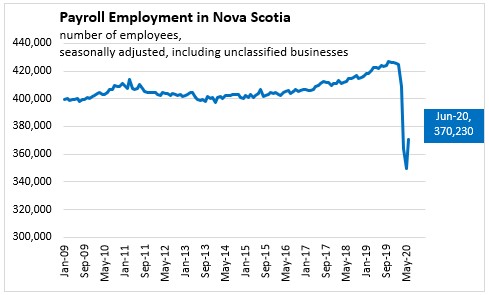

Compared to June 2019, Nova Scotia's payroll employment is down 12.2 per cent. Nationally, payroll employment is down 15.1 per cent in June 2020, with all provinces reporting decreases. The fastest payroll employment decline has been observed in Alberta (-17.3 per cent), Ontario (-16.6 per cent) followed by British Columbia (-14.4 per cent) and Manitoba (-13.7 per cent).

Compared to February 2020, Nova Scotia's payroll employment is down 12.8 per cent. Nationally, payroll employment is down 15.7 per cent in June 2020, with all provinces reporting decreases. The fastest payroll employment decline has been observed in Ontario (-17.3 per cent), Alberta (-16.7 per cent), followed by British Columbia (-15.2 per cent) and Quebec (-14.6 per cent).
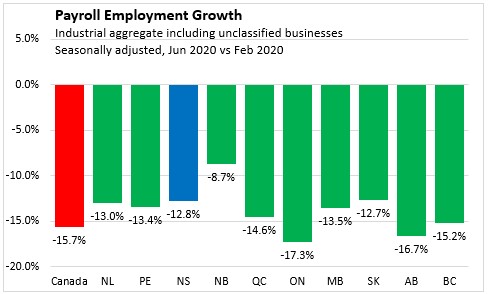
Compared to 2020Q1, Nova Scotia's payroll employment is down 13.8 per cent. Nationally, payroll employment is down 15.8 per cent in 2020Q2, with all provinces reporting decreases. The fastest payroll employment decline has been observed in Ontario (-16.5 per cent), Alberta (-16.1 per cent), followed by British Columbia and Quebec (-15.7 per cent).

In June 2020, payroll employment was down 12.5 per cent in Nova Scotia's goods producing sectors compared to June 2019. Goods sector payroll employment was down for manufacturing (-10.1 per cent), construction (-16.8 per cent) and forestry/logging (-10.8 per cent) sectors compared to June 2019.
Service sector employment was down 11.8 per cent in June 2020 compared to June 2019. Service sector payroll employment decreased the most in percentage terms in arts/entertainment/recreation (-50.9 per cent), accommodation and food services (-40.4 per cent), and other services (-20.4 per cent, including personal services such as hair care). Payroll employment increased in finance and insurance (+2.3 per cent) and management of companies (+1.1 per cent).
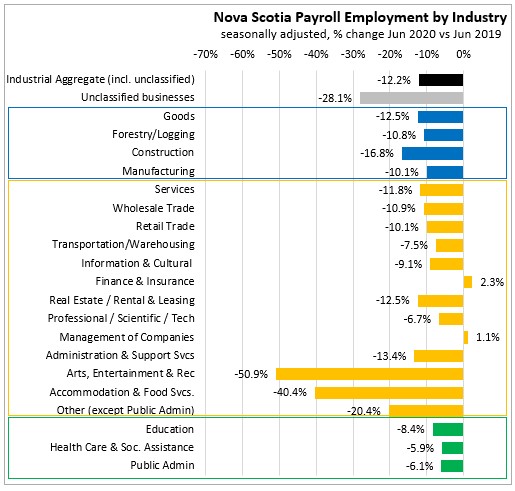
AVERAGE WEEKLY EARNINGS
Changes in average weekly earnings reflect wage growth as well as changes in the composition of employment by industry/occupation/experience, and average hours worked per week. During COVID-19, large employment losses have been reported in industries with relatively low average weekly earnings. This means that average weekly earnings rise because those remaining employed are working in industries with higher average weekly earnings.
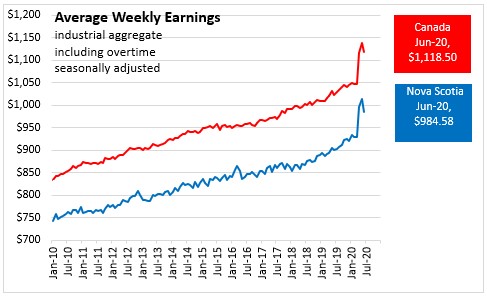
Nova Scotians' average weekly earnings (including overtime, seasonally adjusted) decreased 3.0 per cent ($30.09) from May 2020 to $984.58 in June 2020. Average weekly wages were up 9.5 per cent compared with June 2019. Canadians' average weekly wages decreased 1.8 per cent month to month ($1,118.50 in June) and were 9.4 per cent higher than they were a year ago.
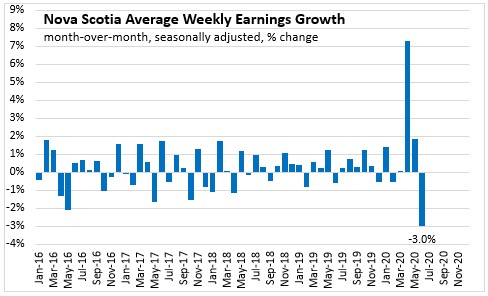
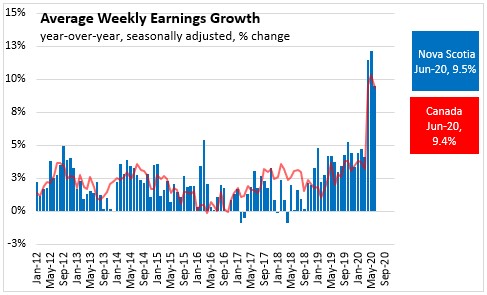
Across the country, there are monthly decreases in all provinces except New Brunswick (+0.1 per cent), with the largest decreases in Saskatchewan (-3.7 per cent), Alberta (-3.6 per cent) and Manitoba (-3.4 per cent).
Compared to a year ago, average wages were higher in all provinces, with the largest increases in percentage terms reported in Prince Edward Island (+13.8 per cent), British Columbia (+11.2 per cent) and Ontario (+10.8 per cent). The slowest year-over-year growth in average weekly earnings was observed in Newfoundland and Labrador (+4.3 per cent) and Alberta (+3.5 per cent).
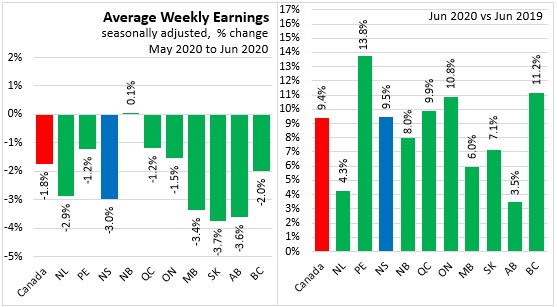
Compared to February 2020, Nova Scotia's average wages were up 6.1 per cent. Nationally, average wages were up 6.9 per cent in June 2020. Average wages were higher in all provinces, with the largest increases in percentage terms reported in Prince Edward Island (+10.8 per cent), Ontario (+8.1 per cent) and British Columbia (+7.7 per cent). The slowest year-over-year growth in average weekly earnings was observed in Newfoundland and Labrador (+4.5 per cent) and Alberta (+2.2 per cent).
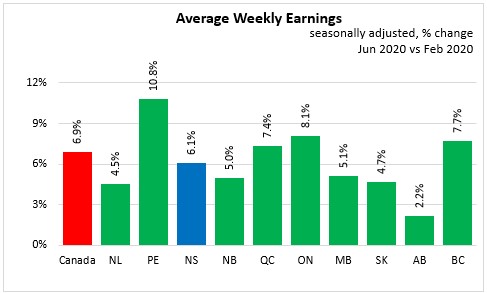
Compared to 2020Q2, nationally and Nova Scotia's average wages were up 7.4 per cent. Average wages were higher in all provinces, with the largest increases in percentage terms reported in Prince Edward Island (+10.6 per cent), British Columbia (+8.4 per cent) and Ontario (+8.0 per cent).
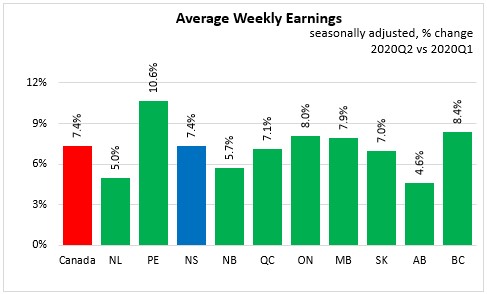
In June 2020 (compared to June 2019), average weekly earnings were up 2.8 per cent in Nova Scotia's goods producing sectors. Goods sector wages were up for manufacturing and construction sectors. Service sector average earnings were up 11.0 per cent in June 2020. Service sector earnings increased the most in percentage terms in arts, entertainment & recreation (+27.0 per cent), management of companies (+21.3 per cent) and transportation/warehousing (+17.1 per cent). The only decline in service sector earnings were in wholesale trade (-1.4 per cent).
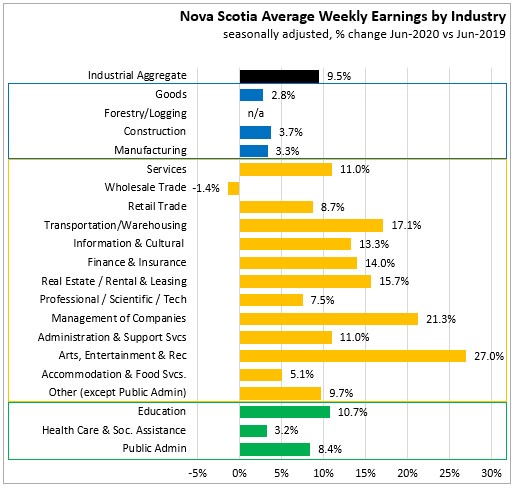
REFERENCE TABLES - (June 2020 vs June 2019)
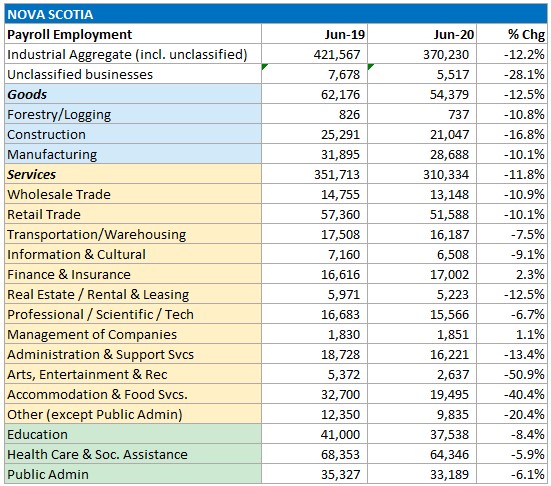
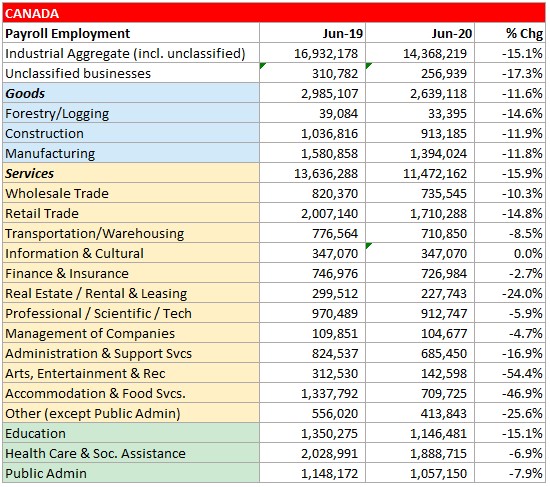
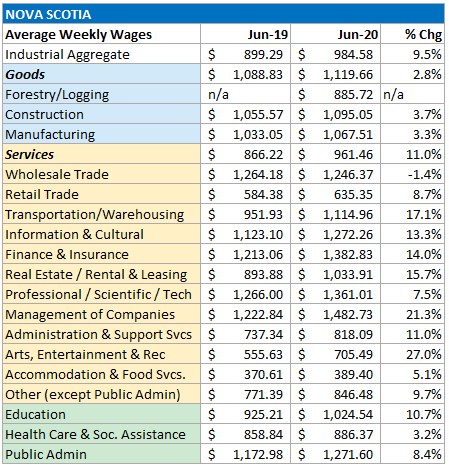
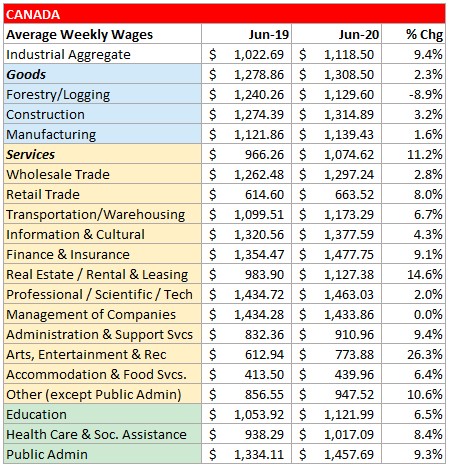
During the COVID-19 pandemic, comparisons of year-to-date averages and sums do not show Nova Scotia’s rapidly changing economic situation. The DailyStats will focus on year-over-year comparisons, comparing one month with the same month in the prior year. Where possible the DailyStats will make comparisons of seasonally adjusted data from the pre-COVID-19 period (January and February 2020) with the period during which COVID-19 measures were in place from March 2020 onwards.
Source: Statistics Canada. Table 14-10-0222-01 Employment, average hourly and weekly earnings (including overtime), and average weekly hours for the industrial aggregate excluding unclassified businesses, monthly, seasonally adjusted; Table 14-10-0223-01 Employment and average weekly earnings (including overtime) for all employees by province and territory, monthly, seasonally adjusted